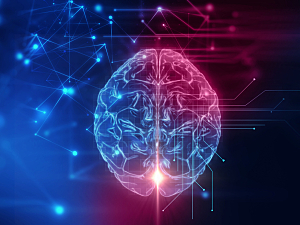Over the past decade, artificial intelligence (AI) and machine learning (ML) have become increasingly prevalent in medicine and healthcare. Brigham and Women’s Hospital neurosurgeon-scientist Timothy R. Smith, MD, PhD, MPH, is actively exploring how to utilize technologies like these to optimize neurosurgical patient care.
Dr. Smith, director of Data Science at the Department of Neurosurgery, is a co-author of three recent papers that offer a glimpse into how AI and ML are transforming the field of neurosurgery. Learn about his academic pursuits aimed at understanding the history of AI and ML, the challenges associated with regulating ML algorithms, and ML’s potential to facilitate real-time quality-of-life assessments.
AI in Neurosurgery
The first of the three papers, published in Diagnostics in July 2023, provides an overview of past and current uses of AI in neurosurgery, such as differential diagnosis, preoperative evaluation, and improving surgical precision. It also makes predictions for future applications, highlighting the potential of ML for tumor identification, surgical outcomes prediction, and more.
The growth of AI has begun to shape the composition of professionals entering the field. Historically, neurosurgery has been the domain of individuals with backgrounds in areas such as genetics, physiology, or molecular or cellular biology. Now it’s drawing rising numbers of engineers, mathematicians, computer scientists, and data scientists.
Dr. Smith notes that unlike epidemiology or randomized clinical trials, for example, most established neurosurgeons do not have a working knowledge of AI and related technologies. He would like to see all neurosurgeons at least achieve a comfort level that enables them to communicate and collaborate effectively with data scientists and other recent entrants into the field.
“In addition, beginning at the medical school level, we need to introduce medical students to ML and AI via programming, computer science and math, and complex statistics,” he says. “That will allow us to usher in a new generation of neurosurgeon-data scientists who understand machine learning, just like my generation came in with an understanding of genetics.”
FDA Approval of Neuroalgorithms
The FDA has traditionally focused on regulating drugs and medical devices. Today, the agency’s purview also includes ML algorithms. Dr. Smith, senior author of a study published in Artificial Intelligence in Medicine that assesses the evidence supporting FDA-approved neuroalgorithms—a subset of ML algorithms that have applications in treating the central nervous system—through a systematic review of the primary literature.
The analysis points to a number of obstacles facing the FDA in evaluating these algorithms—first and foremost, a lack of clinical validation.
“Most algorithms are created in a research context, and less than 5% of them ever make it to the FDA approval process,” Dr. Smith says. “That means many algorithms are created based on a dataset at someone’s home institution. Oftentimes, these algorithms are overfit, and don’t have validity outside that particular small population.”
Dr. Smith argues that neurosurgeons should play a role in tackling the challenges associated with regulating neuroalgorithms. “We need to help the FDA find a pathway toward approval because healthcare data are rapidly being infused with ML and AI,” he says. “If you’re going to use an algorithm to diagnose or treat a brain tumor, that’s very invasive. The more we can work with the FDA to evaluate and get approval for these types of algorithms, the better.”
Predicting Daily Pain Levels in Patients With Spine Disease
Correctly identifying and managing pain is a huge challenge for many physicians. Two decades ago, physicians were thought to be undertreating pain. This assumption led to a rise in prescribing narcotics and ultimately became a contributor to the opioid epidemic that we see today.
In a paper published in Neurosurgery, Dr. Smith and his co-authors explore how to leverage ML to predict a patient’s actual pain based upon features of their digital behavior. The study looked at a cohort of patients with diagnosed neurological spine disease.
Study participants regularly used their smartphones to complete at-home pain surveys, where they rated their pain on a scale from one to 10, and submitted voice recordings in which they read a prompt. In addition, the investigators collected location and other sensor data from the smartphones to ascertain how much each patient moved around each day.
“We discovered we could start predicting the amount of pain patients were in—at least categorically from low, medium, to high pain—based on simple metrics like their level of activity or mobility that day,” Dr. Smith says.
“Then we took it a step further by analyzing their pain scores based upon their voice recordings,” he adds. “If you’re in pain, the way you speak changes. Using ML technology, we analyzed their vocal expression in correlate with the pain they were reporting during that time and came to recognize a pain signature in their voice.”
Dr. Smith believes this approach has the potential to transform pain management. “We’re hoping that one day we can begin to track patients outside the hospital and understand when they actually need more pain management or when it’s time to back off because it looks like they’re hitting all the metrics for a low-pain or pain-free life,” he concludes.
